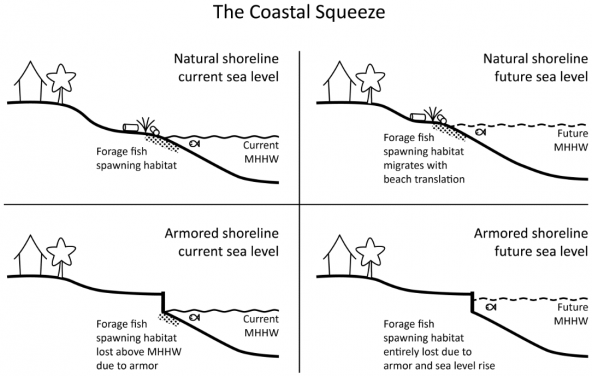
Rising sea levels are expected to exacerbate habitat loss caused by bulkheads, according to studies in the San Juan Islands.

Researchers studying sea level rise in the San Juan Islands in northern Puget Sound have concluded that spawning habitat for surf smelt has already been lost in some areas and will continue to be “squeezed” out by rising sea levels.
One study, which involved 26 surveys for surf smelt eggs on 15 different beaches, is considered the most detailed examination ever conducted of forage fish spawning habitat over a wide geographic area.
That project involved scientists from Friends of the San Juans, Salish Sea Biological and Washington Department of Fish and Wildlife. It was funded by WDFW through an agreement with the Environmental Protection Agency.
The scientific study measured the distribution of surf smelt eggs by removing samples of sand and gravel from different tidal elevations on the 15 beaches. The samples were examined in a lab to determine the density of eggs at the varying locations. Most of the fieldwork was done in the summer and fall of 2013, and some beaches were sampled more than once.
Eggs were found at tidal elevations as low as 3.7 feet above the average daily low tide, known as “mean lower low water” or MLLW. (“Lower low” refers to the lowest tide of the day, since the daily cycle includes two different low tides and two different high tides.) Surf smelt eggs were found as high as 9.2 feet above the average low tide. The results confirmed what has been shown in other studies — that surf smelt eggs are typically found high on the beach.
Specifically, more than 80 percent of the eggs were found in upper third of the tidal range, and more than 30 percent were found above the average high tide mark.
Using those figures for egg density and beach elevations, the researchers estimated that a sea level rise of six inches would inundate 19 percent of the surf smelt eggs, while a rise of 1.1 feet would inundate 35 percent. A 2-foot rise would keep 80 percent of the eggs under water, and a 3-foot rise would affect 99 percent of the eggs in their current locations.
The term “coastal squeeze” or “beach squeeze” refers to the idea that a rising sea level will reduce or squeeze out the spawning habitat located below a fixed bulkhead, since the armoring prevents sands and gravels from moving to higher elevations on a beach to maintain some habitat.

A second forage-fish study also funded by WDFW with EPA funds overlaid known forage fish spawning areas with maps showing the location of shoreline armoring.
Shoreline armor was found on 65 beaches containing forage fish habitat, for a total of 1.5 linear miles. The study looked at rising sea levels and considered that shoreline armor may cut off sources of sand and gravel or prevent their natural migration along a shoreline. Among the conclusions:

